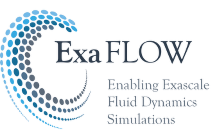Date: June 22, 2017
Location: Frankfurt Marriott Hotel across Messe Frankfurt, Hamburger Allee 2, 60486 Frankfurt am Main, Germany
Registration: http://www.isc-hpc.com/registration.html
The complex nature of turbulent fluid flows implies that the computational resources needed to accurately model problems of industrial and academic relevance is virtually unbounded. Computational Fluid Dynamics (CFD) is therefore a natural driver for exascale computing and has the potential for substantial societal impact, like reduced energy consumption, alternative sources of energy, improved health care, and improved climate models.
Extreme-scale CFD poses several cross disciplinary challenges e.g. algorithmic issues in scalable solver design, handling of extreme sized data with compression and in-situ analysis, resilience and energy awareness in both hardware and algorithm design. The wide range of topics makes exascale CFD relevant to a wider HPC audience, extending outside the traditional fluid dynamics community.
This workshop aims at bringing together the CFD community as a whole, from HPC experts to domain scientists, discuss current and future challenges towards exascale fluid dynamics simulations and facilitating international collaboration.
Agenda:
14:00 - 14:10 Welcome/Intro
14:10 - 14:45 Alexander Heinecke, Intel
14:45 - 15:20 Ingrid Hotz, LiU
15:20 - 15:55 Evelyn Otero, KTH
16:00 - 16:30 Coffee break!
16:30 - 17:05 Keiji Onishi, RIKEN AICS
17:05 - 17:40 Niclas Jansson, KTH (Wrap-up)
Speakers:
Alexander Heinecke, Intel
Title: Seismic Simulations in the Days of Deep Learning Hardware
Abstract: Deep Learning applications are developing themselves into the next killer app and influence/have influenced current hardware platforms substantially towards more regular compute or even fixed function units for dense linear algebra operations. In this talk we will discuss how seismic wave equations can be solved efficiently on modern hardware using FDM and DG-FEM. In both case we introduce novel implementation schemes which optimize bandwidth in case of FDM (via vector-folding) and the efficiency of small sparse matrix products in DG-FEM (via concurrent forward runs). As test platform we used the Cori Phase-II supercomputer hosted at NERSC which comprises of more than 9000 Intel Xeon Phi processors.
Keiji Onishi, RIKEN AICS
Title: Encouragement of Accelerating Pre/Post processing towards Exascale CFD
Abstract: Acceleration of pre / post process is a hidden task to be solved by HPC technology for Exascale CFD. At the site where CFD is actually used, work time due to pre-processing which is relating to shape modification based on ‘’dirty CAD data is still a bottleneck, and it hinders speeding up the entire CFD design process. This also becomes a problem when performing an optimization loop involving a shape change. In addition, the data size obtained by analysis has been increasing year by year, visualization work becomes more difficult as the calculation becomes larger scale. Speeding up its post-processing work is also a problem. This means that even if the operation of the core solver is accelerated, if the whole process can not be speeded up, the benefit obtained will be reduced. Up until now HPC community has turned its attention to speeding up solver, but is it enough? Now is the time to face the clear and present problem. In this presentation, we introduce an example of new analytical methods that do not require pre-processing and parallelized in HPC environment, and discuss how important this concept is with examples. In addition, we will describe the benefits of In-Situ visualization in post-process and introduce practical examples.
Ingrid Hotz, Linköping University
Title: Feature-based Analysis and Visualization in Flow Applications
Abstract: The increasing size and complexity of datasets originating from experiments or simulations raises new challenges for data analysis and visualization. Over the last years, much effort has been put into the development of visualization techniques for steady and unsteady flow fields. The resulting tools are widely used for the everyday visual analysis of flow fields. However, even with advanced visualization tools it is often difficult to understand inherent flow structures, since usually only raw data is displayed. To ease the access of complex flows higher-levels of abstraction can play a substantial role. This is the objective of feature-based visualization. In this talk I will focus on the use of topological methods in this context.
Evelyn Otero, KTH Royal Institute of Technology
Title: The effect of lossy data compression in computational fluid dynamics applications
Abstract: The need for large-scale simulations has been significantly growing in e-Science applications which require more and more data storage and computing resources. Computational fluid dynamics (CFD) is an area where very large amounts of data are produced. In particular, in direct and large-eddy simulations (DNS and LES) a wide range of flow scales are simulated with high fidelity, leading to a large number of degrees of freedom. Thus, storage limitations and also slow I/O (input/output) speed are some of the main limitations when performing large-scale simulations. In this project we analyze the I/O performance of Nek5000 (a spectral element CFD code) and implement parallel I/O strategies to improve I/O performance and scaling. Lossy data compression can be used to mitigate such shortcomings. In particular, the Discrete Chebyshev Transform (DCT) has been used in the image compression community , as well as in CFD. In the present work we assess the use of the DCT in situations such as data postprocessing, vortex identification, as well as restarts from compressed data fields. The latter being relevant in situations where the flow is highly sensitive to initial conditions. In the compression algorithm under consideration, the data is truncated using a priori error estimation, thus allowing total control over the error considered permissible. Note that this is an improvement with respect to previous compression algorithms. Here we illustrate the ability of the data compression algorithm to compress the data at very large scales and on complex grids, with a very good approximation of the total error.
Niclas Jansson, KTH Royal Institute of Technology
Title: Towards Exascale in High-Order Computational Fluid Dynamics
Abstract: TDB
Program committee:
- Prof. Erwin Laure, KTH Royal Institute of Technology
- Dr. Philipp Schlatter, KTH Royal Institute of Technology
- Dr. Niclas Jansson, KTH Royal Institute of Technology
- Prof. Spencer Sherwin, Imperial College London
- Dr. David Moxey, Imperial College London
- Dr. Nick Johnson, The University of Edinburgh, EPCC




